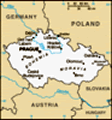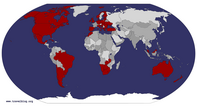Advertisement
Published: June 26th 2016
A rabbit tucked into his evening meal on the grass outside the Ibis Luton Airport. He seemed to be completely at ease, despite being no further than 10 metres from the taxis chaotically parked awaiting their collections at the Terminal. We moved the car to the mid- term car park. The rabbit was still there when we returned. At 4.45 in the morning as we left for our flight, the long eared friend was still at work busy completing the lawn manicure. One of his cousins would have an impact on our trip in a couple of hours time.
Please hurry up and take your seats. We don't want to miss our take off slot. The captain of the Wizzair flight urged his passengers to comply. We taxied on to the runway. Two minutes later, we taxied back off. The pilot was quickly back on the intercom. "Everything is completely normal. There is no cause for concern. An incoming aeroplane has reported hitting a rabbit on the runway. The runway must be checked and the rabbit cleaned up". There is a difficulty believing that there would be anything left of the bunny to clean up, but safety first.
Luton Airport. Once famous for Lorraine Chase, now for rabbits on the runway. It beats leaves on the line for a delay. Ten minutes later, we were airborne.
We arrived about 10 minutes late into Brno. The delay was not significant, but significant enough that the bus to town was just pulling away as we headed out of the terminal building. Brno Airport was disproportionately small for a city of 400,000. The terminal looked as though it had received an EU makeover and sported a roof structure that resembled an armadillo. If it had been a roof on a football stand, I would have been impressed. I went back inside to get bus tickets and in the absence of any all day tickets for sale, settled for 2 zone, 60 minute tickets at 25 Czech Crowns (1 Euro) each. The Number 76 bus took a mere 20 minutes and deposited outside the Brno H nl - central train station. We headed outside to look for a Line 12 tram, which would deposit us outside our hotel. The Other Half gets irritated when the hotel transfer is a bit of a marathon, so even she was impressed that

 Church of St Jacob
Church of St Jacob
......... the view from the Panoptikum aka Football Barwithin 20 paces of getting off the tram we were in the Brno Palace lobby. The upmarket choice was a wedding anniversary concession and way off track from my normal ex-Communist tower block choice. The first impressions of the building were good with the courtyard of the old building having been transformed into a huge greenhouse. The smile was wiped off our faces, when no rooms were yet available for check-in. This of course would not have happened in the usual standard of hotel, where staff normally comfortably outnumber the guests. We left the bags and headed out into the lunchtime sun.
The centre of the city is quite compact and dominated by 2 main squares. The centre was alive with some form of festival, but more of that later. We caught a tram north to our lunch venue. Cafe Era is a modernist building from the 1930s. Plain and simple from the exterior, it hides a striking staircase. The shell of the building inside is minimalist. The eyes are drawn to the staircase, stunningly painted in the Czech national colours - red, white and blue. A large family party were celebrating an occasion to our left.
The majority of the other tables were full. Alas, the food menu was all on a blackboard - in Czech. The waitress helpfully translated the choices. The choices included rabbit, although possibly not one of the Luton natives. We ordered and settled down to the first beer of the trip. Brno prices and I would get along just fine, I mused. 31 Czech Crowns a pint (1.20 Euros). The food was good too - a lamb dish for the Other Half and pasta for myself.
We set off for the reason to visit this suburb of northern Brno - Villa Tugendhat. If you like modernist houses, you would want to live in Villa Tugendhat. The villa was a special commission by architect, Ludwig Mies van der Rohe.
The Tugendhat family were wealthy Jewish industrialists, who owned various businesses in Brno. Mrs Tugendhat had seen the work of modernist architects in Berlin and wanted to create something similar for her new family home. The land used on
the slope behind her parents own villa had panoramic views over the city and lent itself beautifully to the concept of an upside down house. The villa interior is only open to small tour groups. Booking is essential and should be done 2-3 months in advance. The planning lead in to this trip did not allow that and all tours - both in Czech and English - were all sold out. The signs on the approach to the Villa were not good. The immediate area on the road facing side was one big sewer project, so photography was impossible. We rang the bell - more in hope than expectation. "Are there any cancellation places for the tours today, we enquired?" How many places? Two. You are lucky, come to the gate and my colleague will meet you". A few minutes later we were relieved of 350 Czech Crowns each and we're on a tour in English. We missed about 2 minutes of the introduction, but that was a small sacrifice. The concept behind the house is Less is More. The majority of the doors are floor to ceiling and made from Indonesian rosewood. The floors are stone or marble. Decoration
is minimal. The space flows. Light flows into the house. The bedrooms of the first floor have picture windows, using the natural elevation of the plot to focus the eye on to the city centre below.
The jewel is the downstairs living space, known as the Glass Room. A huge flowing space fronted with glass allowing the light to flow in. An ingenious motorized mechanism allows two of the huge glass windows to drop and allow fresh air to flood in. A demonstration ensued. The Glass Room was open plan, but subdivided into study and library, lounge, informal dining and through to formal dining spaces. The study area had a huge rosewood desk and the walls were covered with a rosewood wall system for books and storage. The lighting was in the form of 2 PH lights - fixed to the ceiling, as opposed to being hung low like you would see on an episode of Borgen. A lone leather example of the van Rohe designed Tugendhat chair sat next to a nest of tables. This area is divided from the lounge by a huge onyx wall. The lounge is simplicity - two rows of Barcelona chairs
face each other. The Barcelona project was how the world primarily knows the architect and these chairs of the same era lend themselves to space. The Barcelona chair is still in production - at approximately 10,000 Euros each, if you fancy one.
The dining is closed from the kitchen area with a semi circular ebony wood wall. The table is an early form of Dyrlund flip flap table, which with all leaves out can seat 24 people. The room has historical context for the modern Czech and Slovakia nations, as it was here that the separation of the nation's formally took place in 1992.
If you stand back and look at the Villa today, in many ways it is difficult to conceive it was first occupied in 1929. Grand Designs would have a field day exploring the clean lines, the huge open spaces with light flooding in and Kevin Mackay would be standing back in amazement at the way the huge windows drop in the lounge and dining area. The basement reveals an air conditioning system to combat the heat generated by all that glass. The Tugendhat didn't get to enjoy their design for
many years. The rise of National Socialism meant Moravia wasn't a great place to be. As they had vision with their property, they also had the vision to get out. They left their beautiful villa in 1938, mainly for San Gallen in Switzerland.
The Gestapo took over the house and loaned it to Herr Messerschmidt - of the aircraft factories - who lived in the house in the early 1940s. He boxed in the Onyx wall before left, which saved it from those who came afterwards. The end of the War brought the Russians, who cherished their surroundings so much that they kept their horses on the bedroom floor at street level. As popular then in Brno, as they are today in Marseilles. Horses in the Room by Everything But The Girl springs to mind as the soundtrack. The Tugendhats never returned to reclaim the property and the Communist top brass treated themselves to some minimalist German designed living. After the 1968 uprising and the relaxation of some rules, Mrs Tugendhat paid a visit. The Villa received UNESCO world heritage status in 2010 and underwent restoration, so we can appreciate it today.
We left

 Brno
Brno
Hotel Grandezzathe Villa and descended down the hill towards the city centre. The Villa Low Beer owned by Mrs Tugendhat's parents was closed. It faces the Park Luzanky - the oldest public park in the current Czech Republic by all accounts. It was warm. Young people were liberally scattered on the grass. The good folk of Brno were walking their dogs. The dangerous dogs of Brno? A high percentage were wearing muzzles - the dogs that is, not the people! German shepherds perhaps, but quite what the Yorkshire terriers or King Charles spaniels had done to deserve it is anybody's guess. We would later observe that Yorkies were by far and away the most popular hounds in town. We retreated for a pint of Starobrno at Cafe Bar Panoptikum - it would become our local. The Other Half became reacquainted with Krusovice wheat beer and met up with some Zulus - 10 years after she met the real ones on their home turf......
https://www.travelblog.org/Bloggers/John---Miranda/page-23.html
Advertisement
Tot: 0.089s; Tpl: 0.013s; cc: 17; qc: 31; dbt: 0.0461s; 1; m:domysql w:travelblog (10.17.0.13); sld: 1;
; mem: 1.2mb


























Rainyb
Lorraine Brecht
ooooooooo that's different LOL